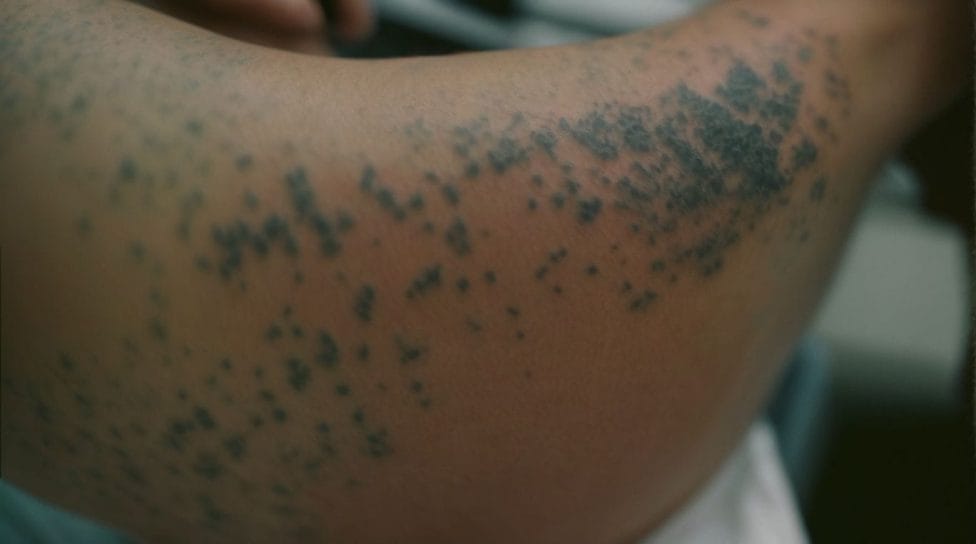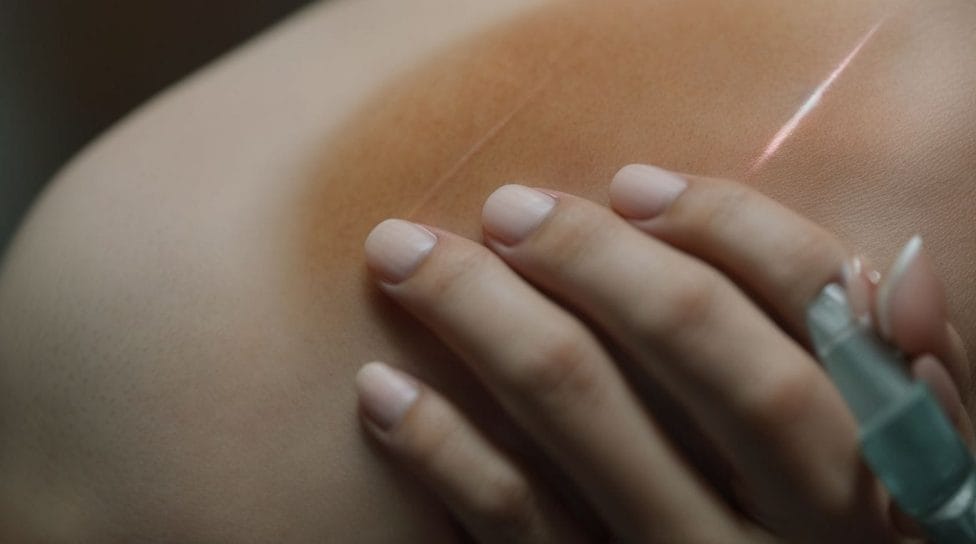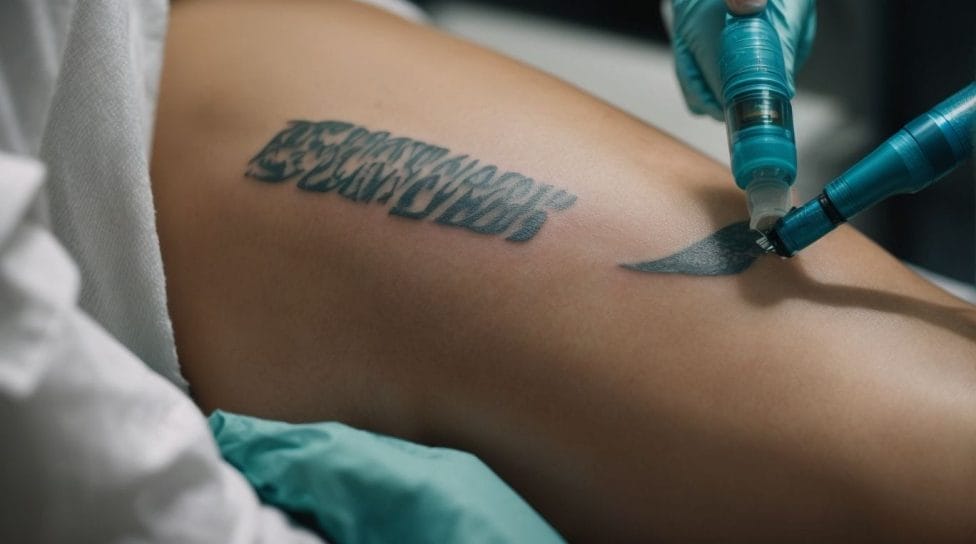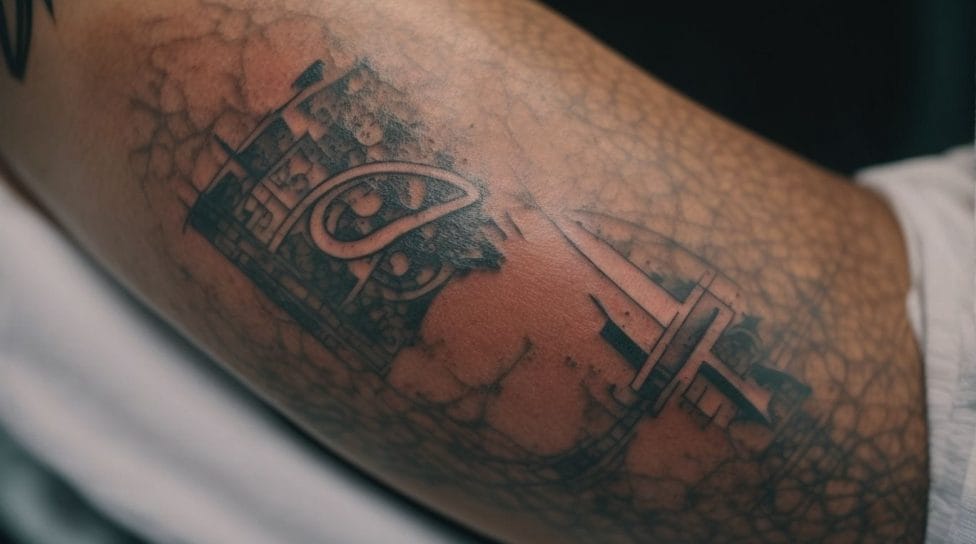Tattoos are a form of permanent body art, but what if you want to remove them? The good news is that tattoo removal is possible, although the process can be complex and may not guarantee complete removal. Various methods have been developed over the years to remove tattoos effectively. Let’s explore the tattoo removal process and the factors that can affect its success.
The most common tattoo removal method is laser tattoo removal, which uses laser technology to break down the ink particles in the skin. Surgical tattoo removal involves physically cutting out the tattooed skin. Dermabrasion involves removing the tattoo using a high-speed brush to exfoliate the skin. Chemical peels use acids to remove the outer layers of the skin and fade the tattoo.
Several factors can influence the success of tattoo removal. The size and placement of the tattoo, as well as the color and type of ink used, can affect the removal process. The individual’s skin tone and the age of the tattoo can play a role.
It’s important to note that tattoo removal may not work for everyone. Some tattoos may only partially fade, resulting in the lightening of the tattoo rather than complete removal. The effectiveness and results of tattoo removal can vary depending on the individual and the tattoo.
While tattoo removal techniques have improved over the years, it’s worth mentioning that the process can be painful and may have side effects. Common side effects include redness, swelling, and blistering of the treated area.
For those who are not interested in tattoo removal or are seeking alternative options, there are alternatives available. Tattoo cover-ups allow you to transform your existing tattoo into a new design. Tattoo fading creams claim to lighten the tattoo over time, although their effectiveness is debated.
While tattoo removal is possible, it’s essential to consult with a professional to understand the best approach for your specific tattoo. It’s also important to manage expectations and have a thorough understanding of the potential pain, side effects, and limitations involved in the process.
Key takeaways:
- Laser tattoo removal: The most common method is for lasers to break down the tattoo pigment, allowing the body to eliminate it gradually.
- Factors affecting tattoo removal: Tattoo size, placement, color, and pigment, as well as skin tone and the age of the tattoo, all play a role in the success of tattoo removal.
- Alternative methods: If tattoo removal is not feasible, options like tattoo cover-ups and fading creams can help modify or minimize the appearance of tattoos.
The Process of Tattoo Removal

Photo Credits: Tattooineplanet.Com by Bradley Rivera
The tattoo removal process is a fascinating journey where the art on one’s skin can be altered or eliminated. In this section, we will uncover the techniques used in tattoo removal, including laser treatments, surgical procedures, dermabrasion, and chemical peels. Get ready to dive into the world of tattoo removal methods, where precision meets technology, as we explore the options available for those seeking a fresh canvas.
Laser Tattoo Removal
Laser tattoo removal is a widely used technique for eliminating undesired tattoos. When contemplating laser tattoo removal, there are several crucial factors to bear in mind:
- Laser technology: The process of laser tattoo removal involves employing high-intensity laser beams to disintegrate the tattoo pigment.
- Treatment sessions: Typically, multiple sessions spaced several weeks apart are necessary for complete removal.
- Tattoo color: Darker shades like black, blue, and green respond better to laser treatment, whereas lighter colors might require additional sessions.
- Pain and side effects: Laser tattoo removal may cause temporary discomfort, such as a burning sensation, as well as redness and swelling.
- Effectiveness: The effectiveness of laser tattoo removal depends on various factors, such as the age of the tattoo, its depth, and the composition of the ink, enabling either lightening or complete removal.
If you are contemplating laser tattoo removal, it is imperative to consult a qualified professional to discuss your specific case and potential outcomes.
Surgical Tattoo Removal
Surgical tattoo removal is a procedure carried out by a professional dermatologist or plastic surgeon. The process involves several steps to ensure the best results.
One of the first steps is the administration of local anesthesia to numb the treated area. This helps to minimize any discomfort that may be experienced during the procedure.
The next step is making precise incisions to remove the layers of tattooed skin. The surgeon removes the tattooed skin layer by layer, ensuring accuracy and precision.
Once the tattooed skin is removed, the surgeon will suture the incision to promote healing. This is an important step to ensure that the treated area heals correctly.
To protect the area and prevent any potential infections, a sterile dressing is applied after the procedure. This helps to keep the area clean and free from bacteria.
It is important to note that the treated area requires time to heal. Proper aftercare instructions should be followed to ensure optimal healing.
Depending on the size and complexity of the tattoo, multiple sessions may be required. This is determined during the follow-up appointments with the dermatologist or plastic surgeon.
Surgical tattoo removal is known to be an effective method for removing tattoos. This procedure is particularly beneficial for tattoos that may be difficult to treat with laser removal methods.
Dermabrasion
Dermabrasion is a tattoo removal method that uses a rotating device to remove the top layers of skin where the tattoo is located. This process helps to fade the tattoo and can be effective for superficial tattoos. It may not completely remove the tattoo, and multiple sessions may be required. Dermabrasion is generally more suitable for small tattoos and may not work well for larger or more complex designs. It is also important to note that dermabrasion can cause pain, swelling, and scarring. As a result, it is recommended to consult with a dermatologist or tattoo removal specialist to determine whether dermabrasion is the right option for tattoo removal.
To learn more about tattoo removal options, you can visit Can Tattoos Be Removed?
In addition to dermabrasion, there are other alternative methods for tattoo removal. Some suggestions include tattoo cover-ups, where a new tattoo is designed to cover the existing one, and tattoo fading creams, which can gradually lighten the appearance of the tattoo. It is important to understand that these alternative methods may not provide the same effectiveness as professional tattoo removal procedures. Consulting with a professional is always the best approach to determine which tattoo removal method will work best for individual circumstances.
Chemical Peels
Chemical peels
Chemical peels are a technique commonly utilized for tattoo removal. This involves applying a chemical solution to the skin, which prompts the outer layers of the skin to peel away. Through this gradual process, the tattoo gradually fades over time. It is essential to understand the following key aspects of chemical peels for tattoo removal:
- Procedure: The tattooed area is treated with the chemical solution and left for a specific duration before rinsing it off.
- Depth: Chemical peels primarily target the superficial layers of the skin, making them ideal for tattoos that are not deeply embedded.
- Effectiveness: Chemical peels can lighten the appearance of a tattoo, although complete removal may not be achieved.
- Multiple Sessions: Achieving noticeable fading or removal often necessitates multiple sessions of chemical peels.
While chemical peels can be effective for certain individuals, it is crucial to consult with a professional to determine the most suitable removal method for your specific tattoo. Additionally, exploring alternative methods such as laser removal or tattoo cover-ups may be worth considering.
Factors Affecting Tattoo Removal

Photo Credits: Tattooineplanet.Com by Bruce Scott
In tattoo removal, several crucial factors can impact the process. We’re about to uncover the key elements that come into play when removing a tattoo, from the size and placement of the tattoo to the color and pigment used, as well as the person’s skin tone and the age of the tattoo itself. Brace yourself as we dive into the fascinating world of tattoo removal factors!
Tattoo Size and Placement
Size and placement are important factors to consider regarding tattoo removal. Here are some steps to consider when dealing with different tattoo sizes and placements:
- Small tattoos: Tattoo size and placement play a significant role in the ease of removal. One advantage of small tattoos is that they require fewer sessions and are less time-consuming to remove.
- Large tattoos: On the other hand, the size of a tattoo can also be a challenge when it comes to removal. Larger tattoos may take longer to remove as they require multiple sessions and may involve more discomfort.
- Finger tattoos: Finger tattoos, due to their size and constant movement, can be particularly challenging to remove. The limited amount of skin on the finger adds an extra level of difficulty.
- Face or neck tattoos: These areas, often having sensitive skin, demand extra caution during the removal process. Tattoo size and placement should be carefully considered to ensure a safe and effective removal.
Sarah had a small tattoo on her forearm that she wanted to remove. It took her four sessions of laser tattoo removal to get rid of it completely. The process was relatively quick, and she experienced minimal discomfort. Sarah was pleased with the results and now feels more confident in her tattoo-free forearm.
Tattoo Color and Pigment
| Tattoo Color and Pigment |
| Tattoo color and pigment play a significant role in the effectiveness of tattoo removal procedures. |
| Dark colors like black, blue, and green are easier to remove. |
| Lighter colors like yellow, orange, and white are more challenging to remove. |
| Multiple sessions may be required to fade or remove completely lighter-colored tattoos. |
| Laser tattoo removal is the most common method for removing various colors, as lasers can target specific pigment wavelengths. |
Skin Tone
A person’s skin tone can influence the effectiveness of tattoo removal. Skin tone affects the way laser technology interacts with the tattoo pigment. Light skin tones: Laser tattoo removal tends to be more effective on lighter skin tones. The contrast between the light skin and the tattoo pigment makes it easier for the laser to target and break down the ink. Darker skin tones: Individuals with darker skin tones may experience more challenges with tattoo removal. The laser may have difficulty distinguishing between the tattoo pigment and the surrounding skin, which can lead to potential complications. Consultation: People with darker skin tones must consult a professional experienced in tattoo removal procedures to determine the most suitable approach for their skin type.
- Light skin tones: Laser tattoo removal tends to be more effective on lighter skin tones. The contrast between the light skin and the tattoo pigment makes it easier for the laser to target and break down the ink.
- Darker skin tones: Individuals with darker skin tones may experience more challenges with tattoo removal. The laser may have difficulty distinguishing between the tattoo pigment and the surrounding skin, which can lead to potential complications.
- Consultation: People with darker skin tones must consult a professional experienced in tattoo removal procedures to determine the most suitable approach for their skin type.
Historically, diverse cultures worldwide have practiced tattooing for thousands of years. From the intricate designs of ancient Polynesians to the symbolic tattoos of Maori tribes, skin art has served as a form of expression, cultural identity, and storytelling. As tattooing techniques and technologies continue to evolve, so does the pursuit of effective tattoo removal options for individuals of all skin tones.
Age of the Tattoo
The age of the tattoo is a crucial determinant to consider when it comes to tattoo removal. The efficacy of the removal process can vary depending on the duration the tattoo has been on the skin. Generally, older tattoos prove to be more easily removable in comparison to newer ones. This is because, over time, the tattoo ink gradually breaks down and fades. Newer tattoos, on the other hand, often exhibit deeper and more vibrant colors, thereby posing a greater challenge in the removal process. Nevertheless, with the advancements in tattoo removal technology, it remains feasible to remove tattoos of any age.
Does Tattoo Removal Work for Everyone?

Photo Credits: Tattooineplanet.Com by Eugene Gonzalez
Does Tattoo Removal Work for Everyone?
Tattoo Removal is not guaranteed to work for everyone. The success of tattoo removal depends on various factors, including the size, color, and location of the tattoo, as well as the type of laser used. Dark-colored tattoos are generally easier to remove, while lighter colors may require more sessions. Individuals with darker skin tones may have a higher risk of experiencing side effects such as hyperpigmentation or hypopigmentation. It is crucial to consult with a professional to determine the best approach for your specific tattoo. Pro-tip: It is recommended to research and find a qualified practitioner with experience in tattoo removal to ensure the best results.
Effectiveness and Results of Tattoo Removal

Photo Credits: Tattooineplanet.Com by Juan White
Discover the remarkable effectiveness and incredible results of tattoo removal. From lightening tattoos to achieving complete removal, this section reveals the secrets behind saying goodbye to unwanted ink. Prepare to be amazed as we explore the methods and techniques that can fade tattoos or even make them disappear entirely, bringing a fresh start to those seeking a new canvas. Get ready for a journey into tattoo removal and its possibilities.
Lightening of the Tattoo
Lightening the Tattoo is a common goal for individuals seeking tattoo removal. This process involves multiple steps:
- Laser treatment: A specialized laser breaks the tattoo ink into smaller particles.
- Body’s natural response: The immune system works to remove the fragmented ink particles from the skin.
- Multiple sessions: Depending on the size and color of the tattoo, multiple laser sessions may be needed to achieve the desired lightening of the Tattoo.
- Gradual fading: Over time, the Tattoo gradually fades as the ink is removed.
It’s important to note that complete tattoo removal may not always be possible, but lightening the Tattoo can significantly reduce its visibility.
Complete Tattoo Removal
- To achieve complete tattoo removal, it is important to follow a series of steps that will ensure the tattoo is fully eliminated from the skin.
- The first step is to consult a professional tattoo removal specialist. During this consultation, the specialist will assess the tattoo and discuss the best approach for complete removal.
- Next, multiple laser treatments should be chosen. These treatments should be spaced several weeks apart to break down the tattoo ink pigments gradually.
- After each laser session, it is crucial to follow the aftercare instructions properly. This will aid in the healing process and help prevent any complications.
- Regularly monitoring the progress of the tattoo is also important. This involves assessing the fading and lightening of the tattoo after each laser session. Tracking the progress toward complete removal is key.
- In some cases, additional treatments such as surgical excision or dermabrasion may be necessary. This is especially true for larger or more stubborn tattoos that may require extra measures to ensure complete removal.
- Finally, once the tattoo is no longer visible or only minimally visible, the removal process can be considered complete.
To achieve the best results and ensure complete tattoo removal, it is crucial to follow the recommended treatment plan, seek professional assistance, and have realistic expectations about the process.
Pain and Side Effects of Tattoo Removal

Photo Credits: Tattooineplanet.Com by John Wilson
While tattoo removal has become more advanced, it’s important to be aware of the potential pain and side effects associated with the process. Tattoo removal can cause discomfort, ranging from mild irritation to more intense sensations like getting a tattoo. Numbing creams or local anesthesia can help manage the pain. After treatment, it’s common for the area to become swollen and red, which are side effects of tattoo removal. Applying ice packs and following aftercare instructions can help reduce these side effects.
In some cases, blistering may occur, leading to scarring, another potential side effect of tattoo removal. Proper wound care and avoiding picking or scratching the area can minimize the risk of scarring. Tattoo removal can sometimes result in changes in skin texture, such as raised or depressed areas, which are additional side effects. However, these changes are usually temporary and rarely permanent.
Alternative Methods for Tattoo Removal

Photo Credits: Tattooineplanet.Com by Matthew Robinson
Are we looking to bid farewell to an unwanted tattoo? Look no further! In this section, we’ll explore alternative methods for tattoo removal that go beyond costly and painful procedures. Brace yourself as we dive into the world of tattoo cover-ups, where artistic transformation takes the spotlight. And if that’s not for you, we’ll also uncover the realm of tattoo-fading creams, promising a gradual fade to your inked regrets. Get ready to discover hassle-free alternatives to bidding farewell to your once beloved but now unloved tattoos!
Tattoo Cover-ups
Hiding a tattoo with a cover-up is a popular option for those who want to conceal an unwanted tattoo without undergoing tattoo removal. Tattoo cover-ups involve creating a new design that covers the existing tattoo. Skilled artists can use shading, color blending, and incorporating the existing tattoo into the new design to camouflage the old tattoo effectively. Not all tattoos are suitable for cover-ups, especially ones with dark colors or heavy ink saturation. Consulting with a professional tattoo artist is crucial to ensure the success of a tattoo cover-up.
Tattoo Fading Creams
Using tattoo-fading creams can be an alternate approach to removing tattoos.
- Tattoo fading creams function by gradually lightening the tattoo over some time.
- These creams typically contain ingredients such as hydroquinone, kojic acid, or alpha-arbutin, which aid in breaking down the pigment in the skin.
- Consistently applying the cream and following the instructions is essential for achieving optimal results.
- It’s important to note that tattoo-fading creams may not eliminate the tattoo, but they can assist in fading it to a certain extent.
- Results may differ depending on tattoo size, color, and skin type.
Some Facts About Tattoo Removal:
- ✅ Laser removal is the most successful and cost-effective method. (Source: Healthline/Mayo Clinic)
- ✅ Certain colors like black, brown, dark blue, and green are easier to remove than others. (Source: Healthline)
- ✅ Older and stick-and-poke tattoos are easier to remove than newer ones. (Source: Healthline)
- ✅ Larger, more colorful tattoos are more time-consuming and expensive to remove. (Source: Healthline)
- ✅ Removal may be more difficult for those with darker skin, preexisting skin conditions, or health conditions affecting the skin. (Source: Healthline)


